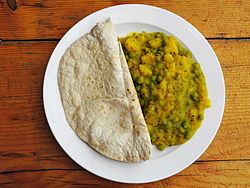Phulka

Plain chapati served with Aloo mattar
|
|
| Alternative names | Rotli, roshi, safati, shabaati |
|---|---|
| Place of origin | Indian Subcontinent |
| Region or state | South Asia, Central Asia, Southeast Asia, East Africa |
| Main ingredients | Flour |
| |
|
| Nutritional value per 100 g (3.5 oz) | |
|---|---|
|
46.36 g
|
|
| Sugars | 2.72 |
| Dietary fiber | 4.9 g |
|
7.45 g
|
|
|
11.25 g
|
|
| Vitamins | |
| Thiamine (B1) |
(48%)
0.55 mg |
| Riboflavin (B2) |
(17%)
0.2 mg |
| Niacin (B3) |
(45%)
6.78 mg |
| Pantothenic acid (B5) |
(0%)
0 mg |
| Vitamin B6 |
(21%)
0.270 mg |
| Folate (B9) |
(0%)
0 μg |
| Vitamin E |
(6%)
0.88 mg |
| Vitamin K |
(0%)
0 μg |
| Minerals | |
| Calcium |
(9%)
93 mg |
| Iron |
(23%)
3 mg |
| Magnesium |
(17%)
62 mg |
| Manganese |
(0%)
0 mg |
| Phosphorus |
(26%)
184 mg |
| Potassium |
(6%)
266 mg |
| Sodium |
(27%)
409 mg |
| Zinc |
(17%)
1.57 mg |
|
|
|
|
|
| Percentages are roughly approximated using US recommendations for adults. Source: USDA Nutrient Database |
|
Chapati (alternatively spelled chapatti, chappati, chapathi, or chappathi), also known as roti, safati, shabaati and (in the Maldives) roshi, is an unleavened flatbread from the Indian Subcontinent; and popular staple in India, Nepal, Bangladesh, Pakistan, and Sri Lanka. Chapati is made of whole wheat flour known as Atta, salt and water, and is cooked on a tava (flat skillet).
It is a common staple in South Asia as well as amongst South Asian expatriates throughout the world. Chapatis were also introduced to other parts of the world by South Asian immigrants, particularly by Indian merchants to Central Asia, Southeast Asia, East Africa, and the Caribbean islands.
The word chapat (Hindi:चपत, chapat) means "flat", which describes the traditional method of forming rounds of thin dough by slapping the dough between the wetted palms of the hands. With each slap, the round of dough is rotated. Chapati is noted in the 16th-century document Ain-i-Akbari by Abu'l-Fazl ibn Mubarak, vizier of Mughal Emperor Akbar.
Chapatis are one of the most common forms of wheat bread which is staple food in South Asia. The carbonized wheat grains discovered at the excavations at Mohenjo-daro are of a similar variety to an endemic species of wheat still to be found in India today. The Indus valley is known to be one of the ancestral lands of cultivated wheat. Chapati is a form of roti or rotta (bread). The words are often used interchangeably.
...
Wikipedia
